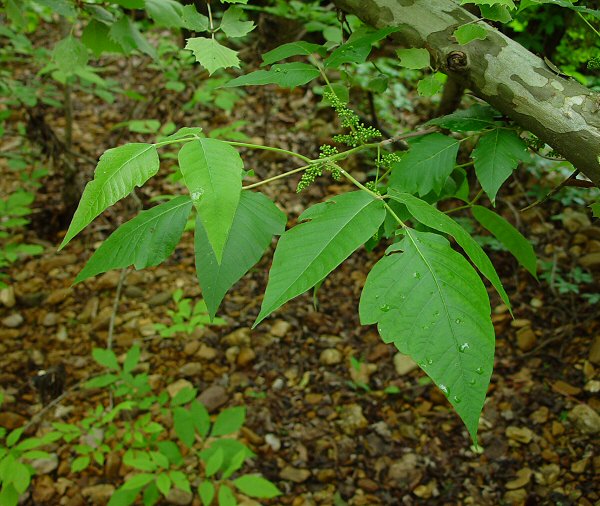Toxicodendron radicans (L.) Kuntze
Poison Ivy

Native
CC = 1
CW = 0
MOC = 56
© DETenaglia
Toxicodendron radicans (L.) KuntzePoison Ivy | |
 |
Native CC = 1 CW = 0 MOC = 56 |
© DETenaglia |
|
Family - Anacardiaceae Habit - Shrubs 0.5-3.0 m tall, or more often lianas to 30 m or more, spreading by rhizomes, often with abundant aerial rootlets. Plants dioecious. Stems - Often woody near base, typically reddish in herbaceous portions. Young shoots densely pubescent to hirsute, greenish. Leaves - Alternate, petiolate, trifoliate. Petioles densely pubescent, 6-15 cm long. Leaflet stalks 2-5 mm long in lateral leaflets, 2-5 cm long in terminal leaflets. Leaflets 5-18 cm long, 4-16 cm wide, ovate, angled to truncate, often unequally so on lateral leaflets, usually angled or tapered to a sharply pointed tip, the margins entire or coarsely and bluntly saw-toothed, sometimes irregularly lobed, those of the lateral leaflets usually somewhat asymmetrical (deeper on the lower side than on the upper side), the upper surface glabrous to sparsely hairy, the undersurface glabrous or sparsely to moderately hairy, especially along veins.
Inflorescence - Axillary paniculate clusters 4-12 cm long, the axis densely pubescent. Pedicels to 2 mm long, pubescent.
Flowers - Sepals 5, 1.2-1.4 mm long, narrowly ovate-triangular, fused at the base. Petals 5, free, 2.4-2.6 mm long, narrowly elliptic, greenish or yellowish white with dark veins, glabrous, spreading to reflexed. Staminate flowers with 5 stamens, these alternating with petals. Filaments whitish to yellowish, glabrous, broader at base than at apex. Anthers orange, 1.2 mm long. Pistillate flowers with a globose ovary. Ovary superior, glabrous. Style short, 3-lobed. Pistillate flowers often with staminal vestiges. Stigmas whitish to yellowish.
Fruits - Subglobose drupes 3-4 mm long, 4-5 mm wide, the outer layer shiny, green when immature, becoming creamy yellow or tan at maturity (September), glabrous, rarely with sparse, minute papillae or hairs, the outer layer becoming papery at maturity and separating, revealing a powdery white middle layer spotted with small, black lines (resin ducts).
Flowering - May - July. Habitat - Bottomland and mesic forests, sand savannas, thickets in upland prairies and loess hill prairies, streambanks, pond margins, ledges of bluffs, fencerows, railroads, roadsides, shaded disturbed areas. Origin - Native to the U.S. Lookalikes - T. pubescens, Acer negundo, Rhus aromatica. Other info. - This plant is common across much of Missouri, although some counties toward the northwestern part of the state are fortunate enough to lack it. It is common throughout most of the eastern half of the continental U.S. In Missouri it is decidedly nonspecific in its habitat requirements and will grow almost anywhere that is not excessively dry. To those who spend copious time outdoors, the plant is trivially easy to recognize, though communicating the recognition pattern to others is not easy. The adage "leaves of three, let it be" is helpful but too broad, since there are plenty of other trifoliate plants which are harmless. In addition to three leaflets, two other characters which point to poison ivy are: 1) the terminal leaflet of the three is on a well-defined stalk (unlike leaves of aromatic sumac), and 2) the leaves are alternate (unlike box elder, which has opposite leaves). The leaflet shape is variable, yet usually easily recognized with practice. They are usually irregularly lobed and asymmetric. The axial clusters of fruits which turn whitish in the late summer are also distinctive. Photographs taken at the Kansas City Zoo, 6-2-00, and in the Ozark Scenic Riverways, Shannon County, MO., 5-18-03 (DETenaglia); also along the Al Foster Trail near Glencoe, St. Louis County, MO, 5-24-2010, the Katy Trail near Dutzow, Warren County, MO, 10-4-2010, Valley View Glade Natural Area, Jefferson County, MO, 5-24-2014, Onondaga Cave State Park, Crawford County, MO, 5-30-2022, and at Little Lost Creek Conservation Area, Warren County, MO, 6-27-2023 (SRTurner). |